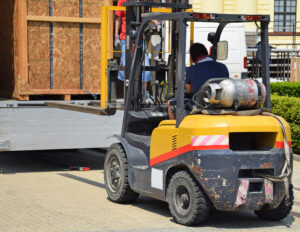Have you been injured in a warehouse through no fault of your own? Now you may be wondering how much compensation for a warehouse accident claim someone can get. This guide aims to answer questions like those and many others.
We’ll explain why compensation in personal injury claims varies, what factors can influence payouts, and whether financial losses are covered. Further, we discuss who is liable when a worker is injured in a warehouse accident. In addition, you will see some examples to get an idea of what a duty of care is and how it relates to compensation claims.
After this, our guide will detail the evidence and time limits that are involved in the claims process. Finally, we explain how a No Win No Fee solicitor from our expert panel could support you throughout the entire warehouse accident claims process.
While you read the sections below, please know that you can contact our advisory team with any questions about a warehouse accident claim at any time. You can:
- Ring us for free, impartial guidance on 0800 408 7826
- Contact us here to submit a claim.
- Ask the live chat a question.
Frequently Asked Questions
- How Much Compensation For A Warehouse Accident Claim Could I Get?
- What Factors Determine Warehouse Accident Compensation?
- Can I Make A Warehouse Accident Claim?
- Who Is Responsible For Warehouse Worker Safety?
- Examples Of How Accidents Can Occur In A Warehouse
- How Do I Make A Claim For Warehouse Accident Compensation?
- Is There A Time Limit To Claim For Accidents In A Warehouse?
- How Can A Conditional Fee Agreement Help Me Make A Claim?
- Learn More
How Much Compensation For A Warehouse Accident Claim Could I Get?
Many factors can influence how much compensation for a warehouse accident claim someone gets. Those involved in assessing the value of your injuries (known as general damages) might use your medical evidence and a publication called the Judicial College Guidelines (JCG).
This document contains suggestive compensation brackets for a range of injuries, some of which have been included in a table below. Please keep in mind that the top figure isn’t from the publication, and this table is intended as guidance only:
Compensation Guidelines
| Injury Area | Severity | Compensation Guidelines | Notes |
|---|---|---|---|
| Multiple types of severe injury combined with special damages | Severe | Up to £1 million plus | Severe, multiple injuries and an amount for lost earnings, care provision and medical bills under special damages. |
| Head/Brain | Very severe | £344,150 to £493,000 | This bracket's top range would see a claimant retain some capacity to follow basic commands. However, there will be few indications (if any at all) of a meaningful response to their environment, and language function will be limited or non-existent. There will also be double incontinence and a need for continuous nursing care. |
| Moderate (iii) | £52,550 to £110,720 | Cases involving impact on memory and concentration with reduction in ability to work and possible fatigue. | |
| Neck | Severe (ii) | £80,240 to £159,770 | Cases typically involving serious damage/fractures to cervical spine discs, causing permanent, such as permanent brachial plexus damage. |
| Chest | (b) Traumatic injury | £80,240 to £122,850 | Impaired function, reduced life expectancy, physical disability, and permanent damage to lungs, heart, and/or chest. |
| Leg | Severe (ii) Very Serious | £66,920 to £109,290 | Injuries that are bad enough to create mobility problems that are permanent, with a need for mobility aids or crutches. This bracket can also include injuries involving multiple fractures that took years to heal, leading to serious deformity/movement limitation. |
| Hand injuries | Severe finger fractures | Up to £44,840 | May result in partial amputations that lead to deformity, grip impairment, and a disturbance of sensation. |
| Back | Moderate (ii) | £15,260 to £33,880 | Cases can include backache arising from disturbed ligaments/muscles or prolapsed discs that need a laminectomy. This bracket may consider factors like the extent of pain, what treatments have been needed (or will be), and how it affects a claimant's quality of life. |
| Knee | Moderate (i) | £18,110 to £31,960 | Covers injuries like dislocations and torn cartilages, resulting in instability that is minor, weakness, or other mild disability in the future. |
| Wrist | (c) Less severe | £15,370 to £29,900 | Injuries that can cause some kind of permanent disability, such as pain and stiffness that persists. |
Do you have questions about compensation in warehouse accident claims? Why not get in touch with our advisory team for advice tailored to your unique circumstances?
What Factors Determine Warehouse Accident Compensation?
Successful compensation claims can be made up of 2 categories of loss called general and special damages. General damages can be influenced by factors such as:
- What injuries you suffered in the warehouse accident.
- Whether you suffered psychological harm.
- How severe your injuries are and whether you now have a disability.
- What the prognosis is for recovery.
On top of this head of loss, you may also be reimbursed for various related expenses under special damages. You’ll need evidence in order to do so, such as:
- Statements or payslips that prove your income suffered after the accident.
- Evidence of medical expenses, ranging from treatments to physiotherapy and rehabilitative care.
- Proof of payments for support with day-to-day tasks, like cooking, cleaning, and shopping.
- Invoices and estimates for work to make your home or vehicle more accessible.
- Proof of travel expenditure to essential appointments.
Speak to one of our team members to find out more and see if you have a case for compensation.
Can I Make A Warehouse Accident Claim?
You could be eligible to make a warehouse accident claim if you meet the 3 criteria below:
- You were covered by a duty of care at the time you were injured.
- This duty of care was breached.
- As a result, you were injured.
All 3 points must apply to your specific circumstances in order to seek compensation. Feel free to get in touch if you’d like to discuss eligibility or have general questions concerning our how much compensation for a warehouse accident claim guide.
Who Is Responsible For Warehouse Worker Safety?
As you may know, employers have a duty of care to their staff, which is enshrined by law in the Health and Safety at Work etc Act 1974 (HASAWA). This law requires employers to take reasonable actions to ensure the wellbeing and safety of workers. We will cover what these steps involve later on in this guide.
The Six Pack Regulations
The Six Pack Regulations provide a detailed framework of laws and best practice guidance to employers and staff to protect their safety:
- Workplace (Health, Safety and Welfare) Regulations 1992 – Covers issues like workplace hygiene, adequate lighting, ventilation, temperatures, and proper space allocation for workers.
- Provision and Use of Work Equipment Regulations 1998 (PUWER) – Requires workplace machinery, tools, and equipment to be kept in a safe condition through regular checks, maintenance, and repairs.
- Personal Protective Equipment (Enforcement) Regulations 2018 – Governs an employer’s duty of care to provide their workers with sufficient PPE.
- The Management of Health and Safety at Work Regulations 1999 – Outlines how an employer must conduct regular risk assessments alongside health and safety training.
- The Manual Handling Operations Regulations 1992 – Sets out how employers must take appropriate actions to minimise identifiable risks and conduct risk assessments in cases where manual handling cannot be avoided.
- The Health and Safety (Display Screen Equipment) Regulations 1992 – Details what steps can be taken to avoid damage caused by prolonged exposure to display screens.
You might have grounds to make a warehouse injury claim if your employer failed to meet their obligations. With this in mind, speak to our advisory team to find out whether you could seek compensation today.
Examples Of How Accidents Can Occur In A Warehouse
Warehouses are typically places of frenetic activity, and an accident can happen even where an employer follows appropriate health and safety standards. However, the following sections will show how accidents might occur because of someone else’s negligent actions:
Improper Training
Employers have a duty to ensure staff receive sufficient training to perform their jobs safely. Therefore, your employer may be at fault if:
- You don’t receive the necessary training to safely operate a forklift. Subsequently, you break your leg in a fall from the vehicle.
- Despite not giving you training in appropriate handling techniques, warehouse management has you move a shipment of packages. As a result, you dislocate your shoulder while trying to move 1 of them.
Lack Of PPE
An employer could be liable for injuries caused by inadequate or unsuitable personal protective equipment (PPE). For example:
- You suffer a severe burn injury after your warehouse provides the wrong gloves for moving a hazardous substance.
- You are not given appropriate protective headgear, resulting in a falling object striking you and causing serious head trauma.
Trip Hazards
Warehouse management must take reasonable steps to keep the workplace free from clutter, debris, and other tripping hazards. They may be at fault if :
- Your warehouse fails to mark a spill with clear warning signs, causing you to break a wrist when you slip on the wet floor.
- Management fails to conduct regular risk assessments on walkways, leading you to fracture a bone after tripping on an unattended pallet.
Failing Machinery
Without routine checks and maintenance, machines and hand-held power tools have the potential to cause life-altering accidents. For instance:
- You suffer lasting nerve damage when you use a faulty power tool that hasn’t been subject to regular inspections.
- You sustain multiple injuries when a packing machine crushes your arm after it is left in a state of disrepair by your employer.
Heavy Duty Vehicles
As with other machines, forklifts, mobile platforms, and other heavy duty vehicles must be maintained and repaired as needed. Warehouse management might be liable in scenarios such as:
- You have your left leg amputated and suffer multiple internal injuries after being impaled by a forklift. Management knew the vehicle needed repairs but chose not to remove it from service.
- Your foot is crushed by a motorised vehicle that your employer knew routinely malfunctioned when being started. Despite being aware of this issue, management had decided against ordering repairs.
Manual Handling
Staff should be trained in appropriate manual handling techniques, such as correct bending and lifting. Additionally, employers must assess the weight and size of materials being moved and use staff suitable for the task. A breach in an employer’s duty of care may result in:
- Management asks you to move an object that should be handled by more than 1 worker. Despite this, you have to perform the task by yourself, leading you to suffer a serious back injury.
- Your employer has you carry a large package down a flight of stairs even though your field of view is obscured. Consequently, you fall down the stairs and seriously damage your cervical spine.
Whatever the circumstances of your injury, our team are here to help. So, please reach out for further guidance on warehouse accident compensation claims.
How Do I Make A Claim For Warehouse Accident Compensation?
To start a claim for warehouse accident compensation, you need evidence showing how your injuries were caused by an employer’s breach of health and safety. For instance, you could:
- See if any CCTV footage captured the warehouse accident.
- Ask colleagues or others who saw the accident for their contact information. If you choose to appoint a solicitor from our panel, they can gather supporting statements from them.
- Request copies of your medical notes that detail the injury, treatment, and prognosis.
- Take photos of your injuries and the accident scene. For instance, you could highlight poor lighting in the walkway where you slipped.
- Obtain copies from the accident book if your workplace keeps one.
Keep reading our how much compensation for a warehouse claim guide as we next discuss time limits. Or, call our team to see how we can help.
Is There A Time Limit To Claim For Accidents In A Warehouse?
Yes, there is a 3-year time limit to start personal injury compensation claims as laid out in the Limitation Act 1980. Typically, this time limit commences from the date of the warehouse accident. Time limits can be affected if a claimant cannot start a claim for themselves because they belong to 1 of the following groups:
- Time limits are put on hold for minors, or in this case, apprentices and workers under 18. They are allowed 3 years to initiate an independent claim from the date of their 18th birthday.
- Time limits are also frozen for a mentally incapacitated claimant. Instead, if capacity returns, the 3-year time limit begins from the date of recovery.
Both categories may use a litigation friend to start a claim immediately rather than wait for the time limits to take effect. This role is often filled by a loved one or solicitor and involves carrying out the duties of the personal injury claim and acting in the person’s best interests.
If you want to launch a claim on behalf of someone else, speak to our advisors. Or if you have other questions about how much compensation for a warehouse accident might be owed to you or them, call now.
How Can A Conditional Fee Agreement Help Me Make A Claim?
A Conditional Fee Agreement (CFA) could help you launch a warehouse accident claim without the immediate expense of hiring a solicitor. The solicitors on our panel work on the basis of this type of No Win No Fee contract, meaning:
- No solicitor fees to start work on a claim.
- No fees to move a claim forward.
- No solicitor fees to pay for any completed work should the claim fail.
Your solicitor will get a success fee for their work, taken from the compensation you receive. However, this fee is small thanks to a cap on the percentage that can be taken. Therefore, the bulk of the compensation is yours.
Contact Us
You’ve reached the end of our article, but your compensation journey is only getting started. Find out if you could make a warehouse accident claim by speaking to our advisory team:
- Ring us for free to see if you can claim compensation on 0800 408 7826
- Contact us to submit an online claim.
- Ask our live chat a question.
Learn More
Besides this guide, you can read more here:
- Read about claims made for psychological damage.
- Look at this guide to factory accident claims.
- Check out forklift accident claims in more detail.
External help:
- NHS guidance on checking your condition.
- Learn about the role of the Health and Safety Executive (HSE).
- Lastly, find out how to request CCTV footage.
In conclusion, we hope this guide on how much compensation for a warehouse accident claim can apply has been useful.





